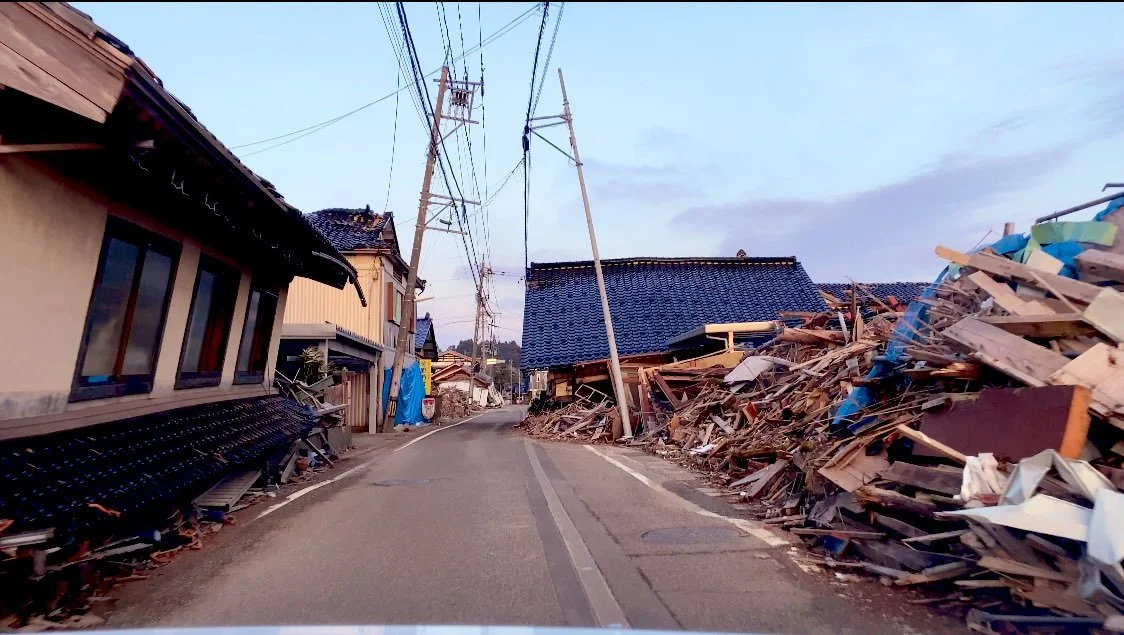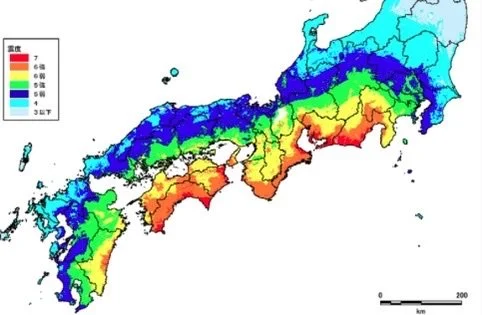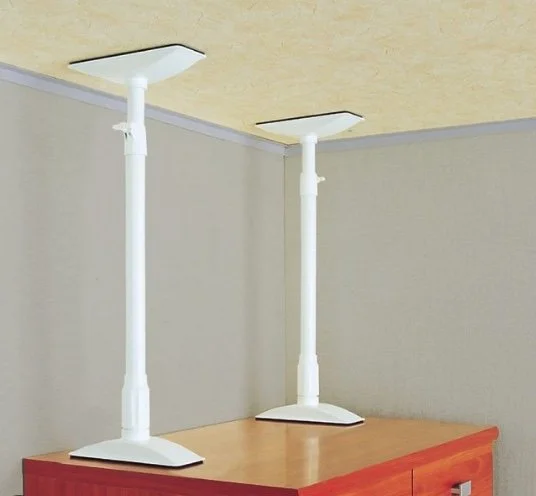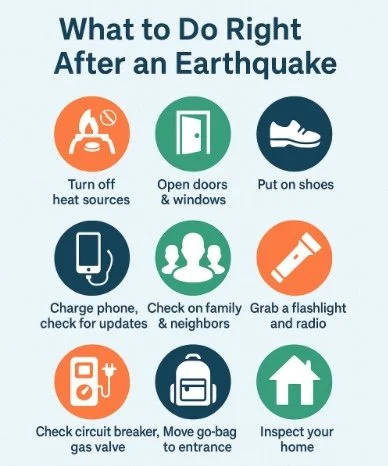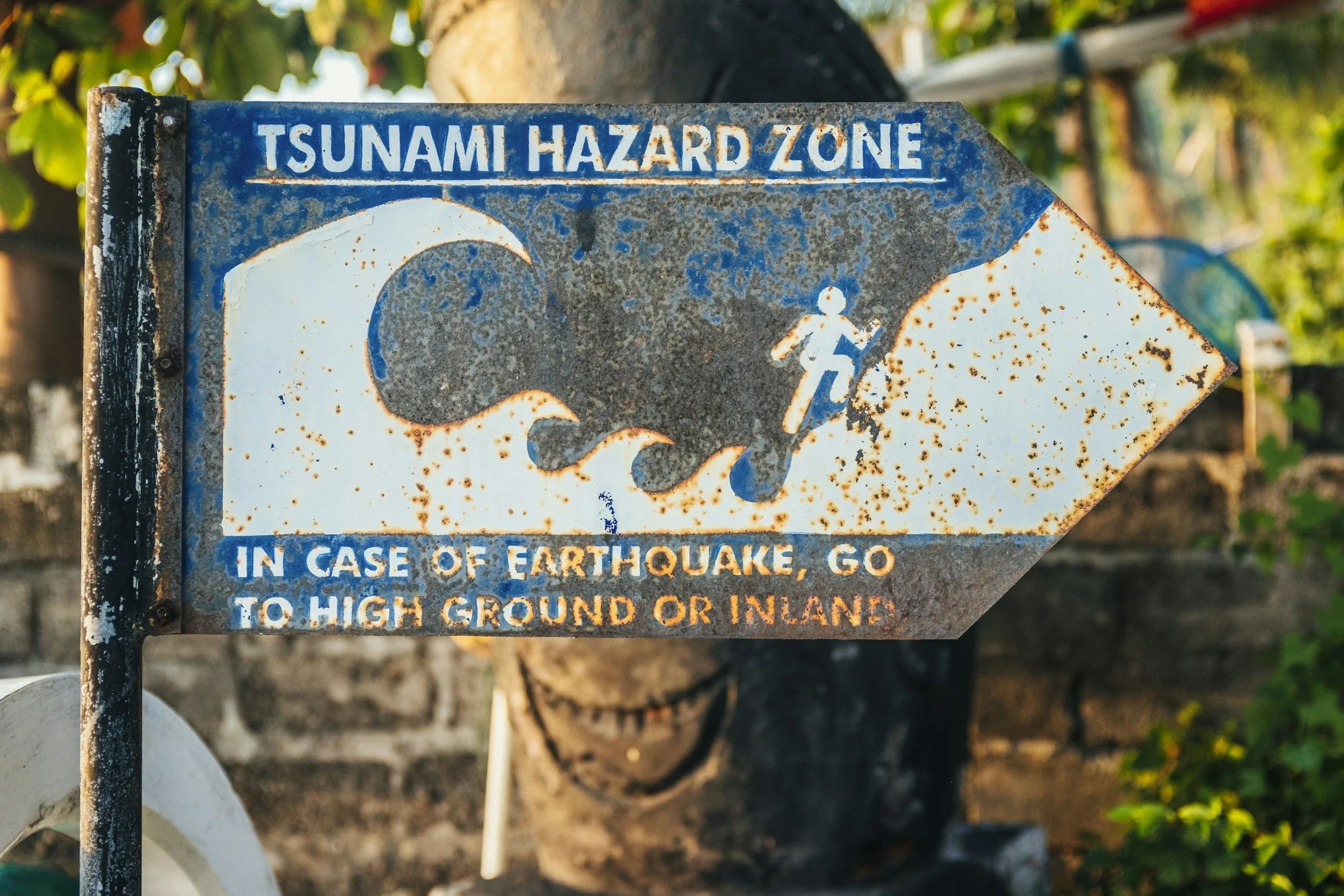Earthquake Survival in Japan: Tips, Tools, and What to Expect
Japan is a safe country when it comes to crime, violence, and terrorism.
However, natural disasters are a different story. Earthquakes, typhoons, and active volcanoes are an unavoidable part of life here, and while the Japanese are generally well-prepared, these events can feel extremely foreign and frightening—especially for newcomers.
The good news is, there’s a lot you can do to protect yourself and your family. In this guide, we’ll walk you through essential facts, practical steps, and helpful resources focused on earthquakes—so you can stay prepared both mentally and physically.
🔹This blog covers:
1. Earthquakes
2. Typhoons
3. Volcanic Eruptions
4. Wrap-Up
The M7.6 Noto Peninsula Earthquake of 2024
1. Earthquakes
🔹Japan's Seismic Reality
Japan lies along the Pacific Ring of Fire and experiences frequent earthquakes—some minor, some major. Two key high-risk areas are:
Nankai Trough (南海トラフ) – Expected to trigger a massive quake with tsunami risk affecting the Tokai, Kansai, and Shikoku regions.
Fukushima/Northeastern Japan – Still seismically active following the 2011 Great East Japan Earthquake.
You’ll often hear about "magnitude" and "seismic intensity (震度)."
Magnitude (M) measures the energy of the quake (e.g., M7.0).
Seismic Intensity is how strong it feels where you are (e.g., Shindo 5, 6, 7).
https://www.data.jma.go.jp/multi/quake/quake_advisory.html?lang=en
Expected seismic intensity from a Nankai Trough earthquake
https://www.jma.go.jp/jma/kishou/know/jishin/nteq/assumption.html
Understand Japan’s Seismic Intensity Scale
Curious what “Shindo 5+” or “Shindo 6-” actually means? Check out this official explanation from the Japan Meteorological Agency.
The Japan Meteorological Agency (JMA) provides early warning alerts that appear on your smartphone, TV, or radio.
🔹Our Story: Earthquake Readiness at Home
The early warning alerts scare me every time—I can feel my heart pounding the moment I hear that sound.
Usually, you only have a few seconds before the shaking starts. It’s not much time, but it’s enough if you don’t panic.
When it happens, we each know what to do. I grab our go-bag and LED flashlight. My husband scoops up Jager—our wire-hair dachshund. Together, we run under the dining table, which is right next to the balcony door.
If we ever need to evacuate, we’re ready to use the emergency hatch on the balcony. It’s a small plan, but it brings us a bit of peace of mind.
🔹Earthquake-Related Risks
Strong earthquakes can trigger secondary disasters:
Tsunamis – Rare in inland areas, but coastal regions must evacuate quickly. Stay alert by monitoring updates via phone, radio, or TV.
Fire – Gas lines or power outages may cause fires. -> If you live in a high-rise apartment, know your evacuation routes. Do not use elevators. Use emergency stairs or evacuation hatches from the balcony if provided.
Landslides – In hilly or weak soil areas.
Liquefaction – When ground turns unstable, often in reclaimed or riverside areas.
Check your neighborhood's hazard map:
Ministry of Land, Infrastructures, Transport and Tourism
🔹What You Need to Prepare
Supplies (Goods) – Stock at least 3 days, ideally 1 week
a. Drinking water (2–3L per person per day)
b. Non-perishable food (don’t forget pet food)
c. Flashlights + spare batteries
d. Portable radio
e. Prescription medication
f. First-aid kit
g. Portable toilet or absorbent pads
h. Mobile Wi-Fi or backup SIM
i. Portable gas stove and butane
j. Hygiene products, menstrual supplies, baby diapers
k. Baseball bat (for breaking doors/windows if trapped)
h. Emergency shoes by your bed
i. Thermal blankets (especially for winter)
j. Fire extinguisher ← Highly recommended! Try one at a local disaster drill if possible.
k. Work gloves ← To prevent injury from debris or falling objects
✅ Tip: Home centers and online stores offer ready-made emergency kits.
Essential Documents and Valuables - Have these in a grab-and-go bag
a. Passport
b. Residence card
c. My Number card / Health insurance card
d. Cash, ATM/credit/debit cards
d. Emergency contact list (family, friends, doctor, pharmacy)
Home Prep – Don’t underestimate the danger of falling furniture
a. Secure furniture and appliances with anti-quake straps - Use L-shaped metal brackets to anchor heavy items to the wall. If you can’t drill into the wall, consider using tension poles instead.
b. Use latches on cabinet doors
c. Don’t hang heavy items above your bed- Store heavy objects on lower shelves to reduce the risk of injury if they fall
d. Apply shatter-resistant film to windows and glass surfaces
e. Have fire-safe equipment like gas stoves with sensors
f. Know how to shut off gas and electricity
Source: Measures to prevent furniture at home from tipping, falling, and moving (English site)
🔹When an Earthquake Hits
Inside a House
a. Drop, cover, and hold under a sturdy table
b. Open doors immediately to secure escape routes
c. Avoid using open flames (Candles, lighters)
Inside a Building (Apartment)
a.Drop, cover, and hold under a sturdy table
b.High-rise buildings sway—don’t panic
c.Help neighbors or ask for help (community spirit matters!)
d.Don’t use elevators
Outdoors
a. Don’t rush home right away—you could become a "帰宅難民 (stranded commuter)"
b. Stay away from walls, signs, and glass windows
c. If in a car, pull over safely and stay inside
d. If in a train or subway, follow staff instructions
🔹What to Do in the Minutes After the Shaking Stops
Turn off heat sources and check for fire
Even if your gas stove or heater has an automatic shut-off, always check manually. Fire is one of the most common causes of fatalities after a quake. If you see or smell smoke or gas, evacuate immediately and call 119.
Open doors and windows to secure an escape route
Earthquakes can shift buildings, causing doors to jam. Right after the tremor, open your front door or balcony to ensure a way out in case you need to evacuate quickly.
Put on shoes immediately
There may be broken glass or debris on the floor. Keep sturdy shoes or sneakers next to your bed, ideally inside a bag or shoebox to prevent dust or falling objects from getting inside.
Charge your phone and check for updates
If the power is still on, charge your phone right away. Use mobile battery packs if you have them. Check NHK, your city’s official website, or a reliable app like “Safety Tips” by JNTO for alerts and evacuation orders.
Check on your family and neighbors
Disasters are easier to overcome when people help each other. If you’re living in an apartment, gently check in with neighbors, especially the elderly, single residents, or those with disabilities. Simply asking “Are you okay?” can make a big difference.
Grab a flashlight and radio
A blackout may follow. Avoid using candles or lighters—there could be a gas leak. LED lanterns and battery-powered radios are safer and more reliable. Don’t rely solely on your phone’s flashlight—it will drain your battery fast.
Check your circuit breaker and gas valve
To prevent post-earthquake fires, turn off the electricity at the breaker and shut off the gas if you suspect a leak. If you smell gas or hear a hissing sound, evacuate immediately and don’t touch switches or electronics.
Move your emergency bag and valuables to the entrance
If you have a go-bag or emergency kit, move it to your front door or a visible spot. Include essentials like water, food, documents, flashlight, medication, and cash. This way, you're ready to leave if evacuation is needed.
Inspect your home carefully
Look for any cracks in the walls, leaning furniture, fallen items, or signs of water or gas leaks. If you notice significant damage or feel unsafe, evacuate calmly and head to the nearest shelter.
Check whether your building was constructed after 1981, when Japan’s updated earthquake-resistant building codes were introduced.
Above all, connect with the people around you and help each other!!!
Tip: When choosing a place to live, make sure the building or house complies with Japan’s updated earthquake-resistant building codes (1981), which were further revised in 2000.
The major revision in 2000 focused on wooden houses, while the seismic standards for reinforced concrete apartment buildings have remained largely unchanged since the 1981 update.
✅Extra Fire Safety Tips
Never use open flames after an earthquake.
Shut off power if evacuating for a long time to avoid “tsuuden kasai” (power restoration fires).
Keep a fire extinguisher and a smoke detector in your kitchen.
Don’t plug multiple appliances back in at once when power returns.
✅ If You Live Alone or Are at Higher Risk
Keep a whistle, flashlight, and shoes by your bed at all times.
Consider hanging a "Need Help" or "I’m Safe" sign on your door—some Japanese municipalities provide these for emergencies.
Connect with neighbors in advance if possible.
🔹When to Evacuate
Elderly, disabled, and vulnerable individuals should evacuate early. Ask for help, if needed.
Know your local evacuation site (避難所)—usually a school gymnasium
If you're in a house and the structure appears undamaged, it may be better and more comfortable to stay home. This is especially true if you have supplies and your utilities (gas, water, electricity) are still functioning.
However, if you feel unsure or unsafe, don’t hesitate to move to a shelter.
If you're in an office building or apartment, staying in place may be the better option. These structures are often reinforced and may provide more protection than public shelters, which typically lack privacy, bedding, and personal supplies.
Note: evacuation sites are basic—no beds, limited partitions, so bring your own privacy items. They should be able to provide some food and water.
2. Typhoons
Typhoons hit Japan mainly between June and October, especially affecting southern areas like Kyushu and Shikoku.
Risk Areas and Hazards
c. Kyushu, Okinawa, and coastal Honshu see the highest impact
b. Linear rainbands (線状降水帯) can cause torrential rains in a short period
c. Related disasters: Flooding, landslides, river overflow
What to Prepare
a. Securely lock windows and storm doors and reinforce them as necessary.
b. Clean gutters and drains to ensure good drainage.
c. Secure items that may be blown away by the wind or store them inside the house to prevent them from flying away.
d. Put shatterproof film on windowpanes and pull down curtains and blinds in case flying objects fly into the house.
e. Same basic goods and valuables as for earthquakes
f. Add rain gear, waterproof storage, and sandbags if on ground floors
g. Store important items on high shelves or upstairs.
What to Do
a. Keep an eye on the weather forecast
b. Don’t go outside during peak storm hours
c. Evacuate early if heavy rain or landslide warnings are issued
d. Stay away from rivers and coastal areas
Source: Prepare for typhoons and heavy rain
3. Volcanic Eruptions
Japan has 110 active volcanoes, including Mt. Fuji. While eruptions are rare, ash fall and air quality may be affected.
What You Can Do
a. Monitor JMA volcanic alerts
b. If visiting active areas like Hakone or Aso, check warning levels before traveling
c. In the case of ash fall: Wear masks, avoid contact lenses, and close windows
4. Helpful Websites for Earthquake Preparedness
Having access to trustworthy disaster preparedness tools is essential in Japan. Below are top resources—official, multilingual, and mobile-friendly—that provide real-time alerts and practical guidance.
Japan Meteorological Agency (JMA) – Disaster Mitigation Information
URL: www.jma.go.jp
Description: The JMA offers real-time earthquake, tsunami, weather alerts, and hazard maps in 14 languages.
Safety Tips App by JNTO – For Travelers and Residents – Highly recommended!
URL: https://www.jnto.go.jp/safety-tips/eng/app.html
Description: A multilingual app providing early warning alerts, evacuation info, emergency phrases, and hazard area guidance. Available in English, Japanese, Chinese, Korean, and more.
Tokyo Metropolitan Government – Tokyo Disaster Prevention Guide
URL: https://www.bousai.metro.tokyo.lg.jp
Description: Offers multilingual disaster prevention manuals, maps, quizzes, and checklists.
U.S. Embassy & Consulates in Japan – Earthquake Preparedness for U.S. Citizens
URL: https://jp.usembassy.gov/services/#emergencyasst
Description: Provides emergency planning advice, STEP enrollment for alerts, and tips for securing your home.
Kyoto City International Foundation – Multilingual Resources
URL: https://www.kcif.or.jp/web/en/livingguide/emergency/
Description: Offers disaster prevention info in 9 languages. Includes how to secure furniture, prepare bags, and apply for a Disaster Victim Certificate (罹災証明書).
Ministry of Land, Infrastructure, Transportation and Tourism (MLIT Disaster Portal
URL: https://www.mlit.go.jp/river/bousai/bousai-portal/en/index.html
Description: A government portal focused on disaster management and mitigation to protect lives, property, and infrastructure.
Tokyo Fire Department – Preparedness Tips
URL: https://www.tfd.metro.tokyo.lg.jp/lfe/bou_topic/jisin/sonae10.html
Description: An official site offering practical earthquake and fire preparedness tips, including emergency supply lists, safety drills, and home safety measures.
• NHK WORLD – Earthquake Updates in English
URL: https://www3.nhk.or.jp/nhkworld/en/news/weather-disaster/earthquake/
Description: Real-time disaster news and quake alerts in English from Japan’s national broadcaster.
• SonaArea Tokyo – Preparedness Center in Ariake <- Recommended
URL: https://www.tokyorinkai-koen.jp/sonaarea/1f.php
Description: Interactive museum that simulates the first 72 hours after a major earthquake.
Experience Seismic Intensity 7 – Honjo Life Safety Learning Center <- Recommended
URL: https://www.tfd.metro.tokyo.lg.jp/taiken/honjo/index.html
Description: Disaster center in Tokyo where you can experience a Seismic intense 7 quake, plus fire and smoke simulations.
✅ Tips for Foreign Residents and Retirees
Language: Register for multilingual alerts from JMA and local municipalities. Make sure you can access real-time information through the apps listed above, as TV and radio broadcasts will primarily be in Japanese.
Insurance: Confirm your home or travel insurance covers natural disasters.
Medical Needs: Store extra medication and prescriptions in your emergency kit.
Mobility: Keep copies of key documents and plan an alternative evacuation method if needed.
4. Wrap-Up
Disasters can be frightening—but fear comes mostly from the unknown.
By learning what to expect, preparing your environment, and even experiencing a Seismic intensity 7 quake simulation, you’ll be better equipped to respond calmly and effectively.
As the Japanese proverb says,
“備えあれば憂いなし – If you are prepared, you need not worry.”
Your First Steps to Safety:
✅ Check your local hazard map for earthquake, flood, or tsunami zones.
✅ Prepare your emergency bag with food, water, lights, and medical supplies.
✅ Make an evacuation and communication plan with your family or household.
Safety in Japan starts with knowledge and action!!
If you found this helpful, please share or bookmark this guide—it might save someone’s life.


